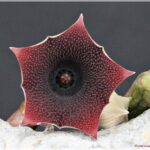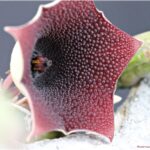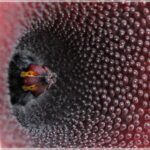Enzianartige (Gentianales) | Hundsgiftgewächse (Apocynaceae) | Seidenpflanzengewächse (Asclepiadoideae) | Ceropegieae | Stapeliinae | Huernia
Synonyme: Ceropegia pendula (E.A.Bruce) Bruyns
Trieb: Huernia pendula unterscheidet sich von allen anderen Huernien durch ihre Wuchsform. Sie hat verzweigte Triebe, die eine Länge von 45 bis 150 cm erreichen können. Bei Bodenkontakt wächst die Pflanze kriechend und fortlaufend wurzelnd, man kann sie aber auch von Felsvorsprüngen und Klippen herabhängend beobachten.
Blüten: Kleine, glockenförmige, tiefkastanienrote Blüten, die unangenehm nach verwesendem Fleisch riechen.
Wissenswertes: In ihrem unzugänglichen Lebensraum auf Felsvorsprüngen ist Huernia pendula vor den Auswirkungen der Beweidung durch das Vieh gut geschützt, die ansonsten in diesem Gebiet eine große Bedrohung für die Pflanzen darstellt.
Das lateinische Epitheton ‘pendula’ bezieht sich auf den hängenden Wuchs der Stängel (und auch der Blüten). Im Englischen wird sie Bootlace genannt, auf Afrikaans Skoenveter-Aasblom, beide Namen bedeuten frei übersetzt „Schnürsenkelblume“, ein Hinweis auf die ungewöhnliche Wuchsform dieser Huernia.
Verbreitung: Diese in Südafrika endemische Art kommt in Flussschluchten in der Transkei und am Ostkap (Bolo und entlang des Mbashe-Flusses sowie bei Collywobbles) vor.
2007
Villiers, AT De
Stapeliads of southern Africa and Madagascar, Peter V. Bruyns, Umdaus Press, Hatfield, 600 pp in 2 Hard Cover Volumes, ISBN 1-919766-37-5 and-38-3, R1400-00, Email: umdaus@ succulents. net Buch
Elsevier, 2007.
@book{de2007stapeliads,
title = {Stapeliads of southern Africa and Madagascar, Peter V. Bruyns, Umdaus Press, Hatfield, 600 pp in 2 Hard Cover Volumes, ISBN 1-919766-37-5 and-38-3, R1400-00, Email: umdaus@ succulents. net},
author = {AT De Villiers},
year = {2007},
date = {2007-01-01},
urldate = {2007-01-01},
publisher = {Elsevier},
keywords = {},
pubstate = {published},
tppubtype = {book}
}
2002
Albers, Focke; Meve, Ulrich
Illustrated Handbook of Succulent Plants: Asclepiadaceae: Asclepiadaceae Buch
Springer Science & Business Media, 2002.
@book{albers2002illustrated,
title = {Illustrated Handbook of Succulent Plants: Asclepiadaceae: Asclepiadaceae},
author = {Focke Albers and Ulrich Meve},
year = {2002},
date = {2002-01-01},
urldate = {2002-01-01},
volume = {4},
publisher = {Springer Science \& Business Media},
keywords = {},
pubstate = {published},
tppubtype = {book}
}
1984
Rauh, Werner
The wonderful world of succulents: cultivation and description of selected plants other than cacti Forschungsbericht
1984.
@techreport{rauh1984wonderful,
title = {The wonderful world of succulents: cultivation and description of selected plants other than cacti},
author = {Werner Rauh},
year = {1984},
date = {1984-01-01},
urldate = {1984-01-01},
keywords = {},
pubstate = {published},
tppubtype = {techreport}
}
0000
Goldblatt, Peter; Manning, John; others,
Cape plants: a conspectus of the Cape flora of South Africa. Buch
National Botanical Institute, 0000.
@book{goldblatt2000capeb,
title = {Cape plants: a conspectus of the Cape flora of South Africa.},
author = {Peter Goldblatt and John Manning and others},
publisher = {National Botanical Institute},
keywords = {},
pubstate = {published},
tppubtype = {book}
}




